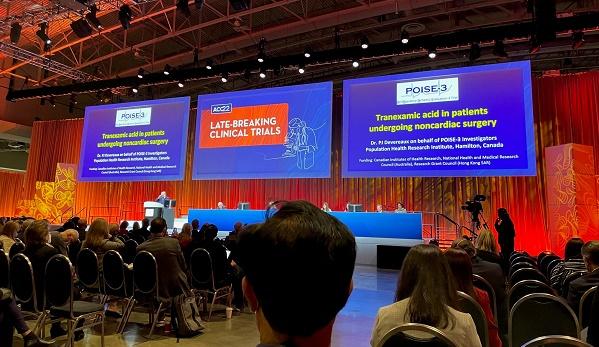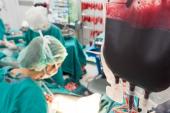POISE-3: Tranexamic Acid Stems Bleeding During Noncardiac Surgery
The results suggest the approach could help alleviate worldwide shortages of blood products, P.J. Devereaux says.

WASHINGTON, DC—Administering tranexamic acid during noncardiac surgery provides a clear reduction in bleeding, with a low likelihood of harm in terms of vascular complications, the POISE-3 trial shows.
The rate of life-threatening, major, or critical organ bleeding at 30 days—the primary efficacy outcome—was 9.1% in the tranexamic acid group and 11.7% in the placebo group, a significant difference (HR 0.76; 95% CI 0.67-0.87), P.J. Devereaux, MD (Population Health Research Institute, Hamilton, Canada), reported here at the American College of Cardiology 2022 Scientific Session.

The primary safety outcome—a composite of vascular complications at 30 days—occurred in 14.2% of patients treated with tranexamic acid and 13.9% of those who received placebo (HR 1.023; 95% CI 0.918-1.142). The noninferiority of tranexamic acid was not established because the upper end of the confidence interval did not fall below 1.125. However, the investigators calculated a 95.6% likelihood that the hazard ratio fell below that threshold.
Devereaux noted, too, that the number of composite vascular events differed by just 10 between the tranexamic acid and placebo arms (649 versus 639).
“So it really makes the probability of any substantial increase in risk very small,” he told TCTMD, saying that he suspects use of tranexamic acid will become more routine in noncardiac surgery based on the POISE-3 results. “What people have to weigh is an unequivocal benefit and a low probability of a small increase in the risk of a complication.”
The approach could potentially provide at least a partial solution to worldwide shortages of blood products, Devereaux indicated. There are more than 300 million major surgeries (more than 95% noncardiac) performed around the world each year, and these account for about 40% of all transfused blood products that are used. “If you can find a way to safely reduce that, you can have a real impact on improving even just the availability of blood for other things that we need it for,” Devereaux said.
The findings were published simultaneously online in the New England Journal of Medicine.
The POISE-3 Trial
Research into ways to improve vascular outcomes in patients undergoing noncardiac surgery has shown that both thrombotic issues and bleeding are important, Devereaux said. The POISE-3 trial was designed to assess whether tranexamic acid, an antifibrinolytic agent that has been evaluated as a way to reduce bleeding in the setting of cardiac and orthopedic surgery, could be of use for reducing bleeding during noncardiac surgery.
The study, conducted at 114 centers in 22 countries, enrolled 9,535 patients (mean age 70 years; 56% men) who were undergoing noncardiac surgery and were deemed to be at risk for bleeding and vascular events. The initial enrollment target was 10,000 patients, but due to slowed recruitment related to the COVID-19 pandemic, the trial leadership decided to halt the study after at least 9,500 patients were included. About 80% of the trial participants were undergoing major surgery.
POISE-3 was a 2x2 factorial trial, also randomizing patients to a hypotension- or hypertension-avoidance strategy. Those results will be presented later in the meeting.
In the current analysis, administration of tranexamic acid—given as a 1-g IV bolus at the start and end of surgery—reduced the risk of composite bleeding events as well as a wide range of other bleeding outcomes, including bleeding independently associated with mortality after noncardiac surgery (8.7% vs 11.3%), major bleeding (7.6% vs 10.4%), ISTH major bleeding (6.6% vs 8.7%), transfusion of at least one unit of packed red blood cells (9.4% vs 12.0%), transfusion of at least two units (6.2% vs 8.3%), and transfusion of two to four units (4.7% vs 6.5%; P < 0.05 for all).
There were no significant differences between the tranexamic acid and placebo groups for life-threatening bleeding (1.6% vs 1.7%) or critical organ bleeding (0.3% vs 0.4%).
The primary safety outcome was a composite of myocardial injury after noncardiac surgery (MINS), nonhemorrhagic stroke, peripheral arterial thrombosis, and symptomatic proximal venous thromboembolism (VTE). The noninferiority of tranexamic acid versus placebo was not established for this outcome, but there were no significant differences seen between trial arms for a variety of vascular outcomes, including MINS, MINS not meeting the definition of MI, MI, and a net clinical outcome incorporating bleeding and vascular events.
Rates of all-cause mortality, vascular mortality, hemorrhagic shock, amputation, symptomatic pulmonary embolism, symptomatic proximal deep vein thrombosis, any proximal VTE, cardiac revascularization, acute kidney injury, new renal replacement therapy, rehospitalization for vascular reasons, seizures, infection, sepsis, and disability were comparable in the two groups. Median length of stay was 4 days and median number of days alive at home was 25 days in each arm.
The blood pressure interventions used in the other part of the trial did not significantly alter either the primary efficacy or the primary safety results.
Overall, Devereaux said, tranexamic acid “looked very encouraging” in the setting of noncardiac surgery, with consistent reductions in bleeding across all forms of surgery. And the totality of the data for tranexamic acid, from POISE-3 and prior trials in other surgical settings, suggests no meaningful difference in safety, he added.
Therefore, Devereaux predicted, “I think we’re going to see more and more uptake of [tranexamic acid] based upon this.” An economic analysis showed that the strategy is cost-saving, he added, noting that tranexamic acid is very inexpensive. “Cost will not be an issue.”
Who Should Get It?
Some questions about the generalizability of the results were raised during a panel discussion after the presentation, but Devereaux indicated that broad use would be justified. Reductions in bleeding with tranexamic acid were seen in both orthopedic and nonorthopedic operations, and across surgery types within the nonorthopedic group. The economic analysis shows, too, that use of tranexamic acid is cost-effective for all patient groups, he added. Moreover, he said, it can be difficult to predict which patients will bleed during surgery because intraoperative mishaps can’t be anticipated.
“Because the drug is so cheap, and actually we can apply it to a broad population, even at an economic level, it looks like it is a winner to give to almost all patients having major noncardiac surgery,” Devereaux said.
Michael Mack, MD (Baylor Scott and White Heart Hospital, Plano, TX), noted that tranexamic acid is routinely used in cardiac surgery and in orthopedic procedures and other types of operations in which significant fibrinolysis would be expected, and said it should be more widely used in noncardiac surgery. “But I would be a little concerned or hesitant to recommend it in the 20% of nonmajor procedures, plastic surgery, urology, and some of these other procedures that aren’t really at risk for major bleeding,” he said.
In response, Devereaux said that bleeding is frequently underestimated by both cardiologists and surgeons. And using the example of urologic surgery, he pointed out that tranexamic acid reduced bleeding, which was relatively common, in that group in the trial.
Commenting during a press conference, Joseph Cleveland, MD (University of Colorado Medicine, Aurora), chair of the American College of Cardiology’s Cardiac Surgery Team Council, said the evolution of approaches in noncardiac surgery—increasing use of robotics, for example, might affect bleeding rates and influence applicability of the POISE-3 results.
“But for now, I think we can safely say for major abdominal operations, major intrathoracic [and] vascular operations, it appears that the use of tranexamic acid will reduce major bleeding outcomes with an adequate safety signal,” Cleveland said, predicting that there would be less uptake of tranexamic acid for other types of procedures.
Todd Neale is the Associate News Editor for TCTMD and a Senior Medical Journalist. He got his start in journalism at …
Read Full BioSources
Devereaux PJ, Marcucci M, Painter TW, et al. Tranexamic acid in patients undergoing noncardiac surgery. N Engl J Med. 2022;Epub ahead of print.
Disclosures
- POISE-3 was supported by a Foundation Grant from the Canadian Institutes of Health Research, a Project Grant from the Australian National Health and Medical Research Council, and a grant from General Research Fund 14104419, Research Grant Council, Hong Kong, and by the Population Health Research Institute.
- Devereaux reports receiving grants/contracts from Abbott Canada, Cloud Dx, Roche Diagnostics, and Siemens.
- Mack reports receiving research grants from Abbott Vascular, Edwards Lifesciences, and Medtronic and serving as an officer, director, or trustee, or in another fiduciary role, with Carmat.
- Cleveland reports a relationship (modest) with Abbott.




Comments